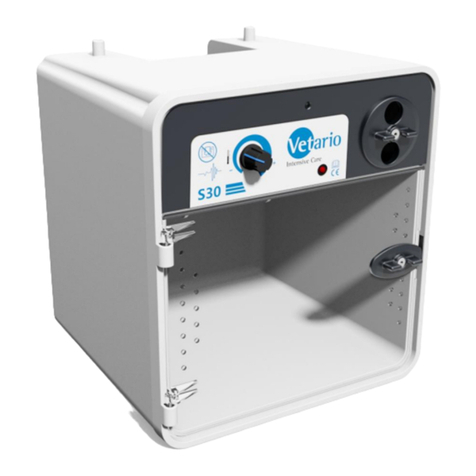HD453 GB Issue 08
3
For indoor use only. (This device is only intended to be used in a dry location with ambient
temperature controlled between 20° - 25°C. Extremes of moisture or temperature may lead to
dangerous malfunction).
This apparatus must be earthed. (The incubator must be connected to the power supply using a
plug and socket with an earth termination. The mains wiring and the appliance should be
periodically checked to ensure earth continuity).
ADDITIONAL SAFETY PRECAUTIONS WHEN USED FOR OXYGEN THERAPY
No auxiliary equipment shall be placed in the incubator. Only use patient connections that are
designed for safe use in an oxygen enriched atmosphere. If in any doubt check with the
manufacturer of the auxiliary equipment. (Fire may be caused by sparking contacts or hot
surfaces in equipment not designed for oxygen service).
Even small quantities of flammable agents, such as ether and alcohol, left in the incubator can
cause fire in connection with oxygen. (Never use flammable cleaners or disinfectants and ensure
such agents are not introduced on a patient).
The incubator must only be used in a well-ventilated room away from potential sources of heat or
ignition. NO SMOKING. Do not use in a confined location, the incubator needs at least 30cm free
space above and to both sides. (Oxygen concentration in the air around the incubator may rise
significantly if ventilation isn’t provided or the space around the incubator is confined. This may
create a fire hazard).
Remove all electrical devices (including the water pump) that are within 90cm of the incubator.
Place the incubator at least 90cm away from power sockets. Ensure there are no power sockets
or electrical items directly under the shelf or table supporting the incubator. (Oxygen gas may
sink through air and cause fire in other equipment).
Before oxygen administration, disconnect any nebuliser and tube from the solution holder. (This
is to prevent oxygen flowing into the nebuliser pump and creating a fire hazard).
If fitted, disconnect the water pump control lead and water delivery tube. (The pump is not
intended for use during oxygen therapy and may create a fire hazard).
Always test the fan rotation and power failure alarms and check ventilation holes before using
with oxygen gas. If the alarm sounds during use disconnect the oxygen supply, disconnect
power and open the door to ventilate the care unit. Do not re-use until the fault has been
investigated and rectified. (Failure of the ventilation fan or blocking of ventilation slots/holes may
lead to oxygen enrichment of air in unintended areas leading to an increased risk of fire. It may
also lead to increased concentration of CO2in the animal cabinet).
Do not exceed 1lpm (one litre per minute) oxygen flow rate. (The maximum safe long-term
concentration of oxygen for canines and felines is achieved at this flow rate and increased flow
may lead to permanent injury or death. Greater flow rates also increase the risk of oxygen
leaking in the event of a fault and could create a fire risk).
The incubator contains no flow restriction or pressure regulator device. The oxygen supply must
be reliably restricted to 400kPa (50psi). Always use a medical grade oxygen pressure regulator
and flow meter that has been serviced in accordance with the manufacturer’s instructions.
Failure of an external device may create a fire or pressure hazard or prevent effective treatment.
It is assumed the operator will be trained in the safe and correct use of such devices.
After oxygen administration, animals and any associated cloth materials must be allowed
sufficient time in the chamber in normal air to allow trapped oxygen to disperse. This may take
30 minutes or more depending on the size of animal and amount of material. (Fabric and similar
materials that trap oxygen enriched air may burn vigorously if ignited by a spark or other source
of ignition).
Be sure to read and follow the material safety data available from your supplier of medical
oxygen gas. Local regulations may apply; your oxygen gas supplier will be able to offer further
guidance. (Some states may apply restrictions on sale or use of oxygen for medical purposes).
Do not obstruct ventilation holes. (Blocking of ventilation slots/holes may lead to oxygen
enrichment of air in unintended areas leading to an increased risk of fire. It may also lead to
increased concentration of CO2in the animal cabinet).






























